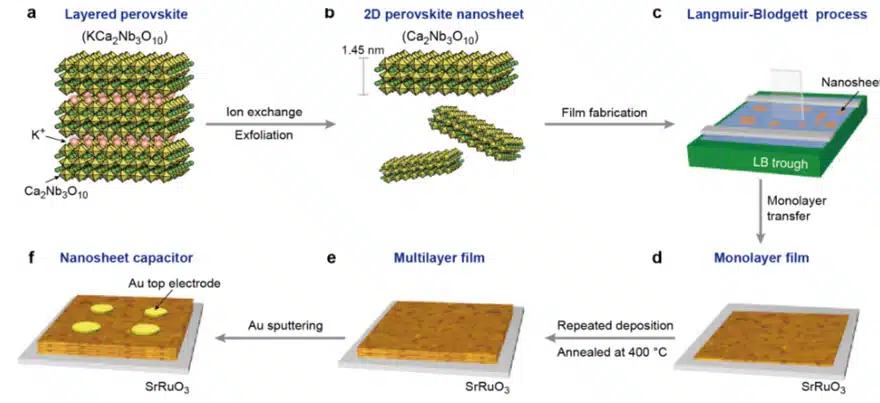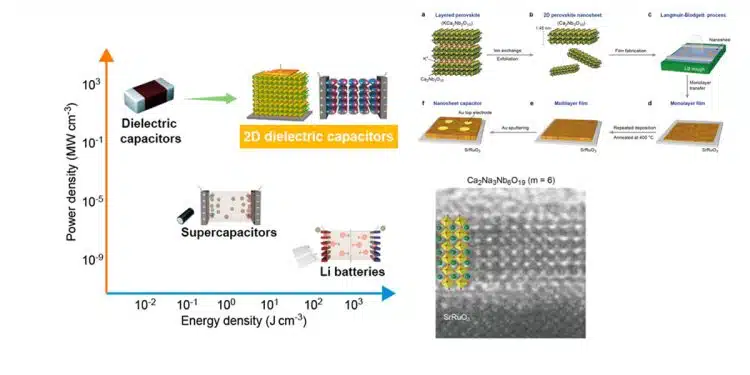A research group led by Professor Minoru Osada at the Institute for Materials and Systems for Sustainability (IMaSS), Nagoya University in Japan, in collaboration with NIMS, has developed a nanosheet device with the highest energy storage performance yet seen. Their results were published in Nano Letters.
Innovations in energy storage technology are vital for the effective use of renewable energy and the mass production of electric vehicles. Current energy storage technology, such as lithium-ion batteries, has long charging times and problems, including electrolyte degradation, lifetime, and even unwanted ignition.
One promising alternative is dielectric energy storage capacitors. The basic structure of the capacitor is a sandwich-like film made of two metal electrodes separated by a solid dielectric film. Dielectrics are materials that store energy through a physical charge displacement mechanism called polarization. When an electric field is applied to the capacitor, the positive charges are attracted towards the negative electrode. The negative charges are attracted towards the positive electrode. Then, storing electrical energy depends on the polarization of the dielectric film by applying an external electric field.
“The dielectric capacitors have many advantages, such as a short charging time of only a few seconds, long life, and high-power density,” Osada said. However, the energy density of current dielectrics falls significantly short of meeting the increasing demands for electrical energy. Enhancing the energy density would help dielectric capacitors compete with other energy storage devices.
Since the energy stored in a dielectric capacitor is related to the amount of polarization, the key to achieving high energy density is to apply as high an electric field as possible to a high dielectric constant material. However, existing materials are limited by the amount of electric field they can handle.
To go beyond conventional dielectric research, the group used layers of nanosheets made of calcium, sodium, niobium, and oxygen with a perovskite crystal structure. “The perovskite structure is known as the best structure for ferroelectrics, as it has excellent dielectric properties such as high polarization,” Osada explains. “We found that by using this property, a high electric field could be applied to dielectric materials with high polarization and converted into electrostatic energy without loss, achieving the highest energy density ever recorded.”
The findings of the research group confirmed that nanosheet dielectric capacitors achieved a 1-2 orders of magnitude higher energy density while maintaining the same high output density. Excitingly, the nanosheet-based dielectric capacitor achieved a high energy density that maintained its stability over multiple cycles of use and was stable even at high temperatures up to 300°C.
“This achievement provides new design guidelines for the development of dielectric capacitors and is expected to apply to all-solid-state energy storage devices that take advantage of the nanosheet’s features of high energy density, high power density, short charging time of as little as a few seconds, long life, and high temperature stability,” Osada said. “Dielectric capacitors possess the ability to release stored energy in an extremely short time and create an intense pulsed voltage or current. These features are useful in many pulsed-discharge and power electronic applications. In addition to hybrid electric vehicles, they would also be useful in high-power accelerators and high-power microwave devices.”
Abstract
Dielectric capacitors have greater power densities than batteries, and, unlike batteries, they do not utilize chemical reactions during cycling. Thus, they can become ideal, safe energy storage devices. However, dielectric capacitors yield rather low energy densities compared with other energy storage devices such as batteries and supercapacitors. Here, we present a rational approach for designing ultrahigh energy storage capacitors using two-dimensional (2D) high-κ dielectric perovskites (Ca2Nam–3NbmO3m+1; m = 3–6). Individual Ca2Nam–3NbmO3m+1 nanosheets exhibit an ultrahigh dielectric strength (638–1195 MV m–1) even in the monolayer form, which exceeds those of conventional dielectric materials. Multilayer stacked nanosheet capacitors exhibit ultrahigh energy densities (174–272 J cm–3), high efficiencies (>90%), excellent reliability (>107 cycles), and temperature stability (−50–300 °C); the maximum energy density is much higher than those of conventional dielectric materials and even comparable to those of lithium-ion batteries. Enhancing the energy density may make dielectric capacitors more competitive with batteries.

Journal Reference:
Hyung-Jun Kim, Shu Morita, Ki-Nam Byun, Yue Shi, Takaaki Taniguchi, Eisuke Yamamoto, Makoto Kobayashi, Yasuo Ebina, Takayoshi Sasaki, Minoru Osada. Ultrahigh Energy Storage in 2D High-κ Perovskites. Nano Letters, 2023; 23 (9): 3788 DOI: 10.1021/acs.nanolett.3c00079
































